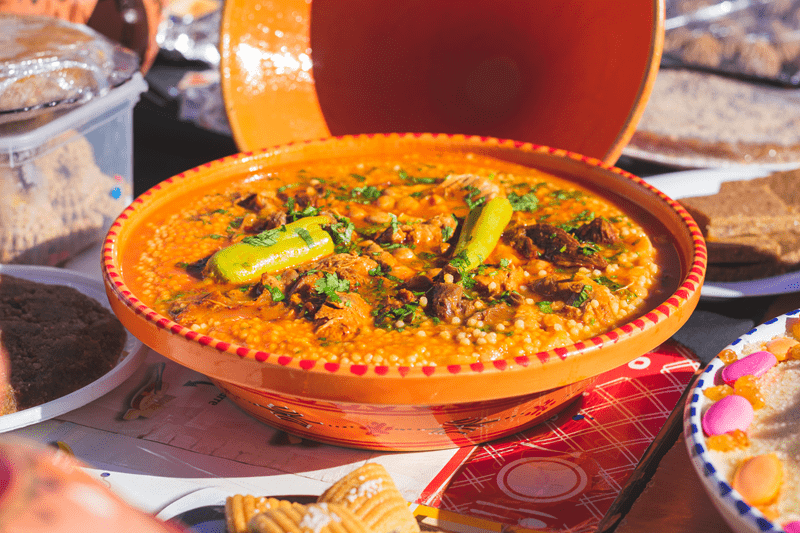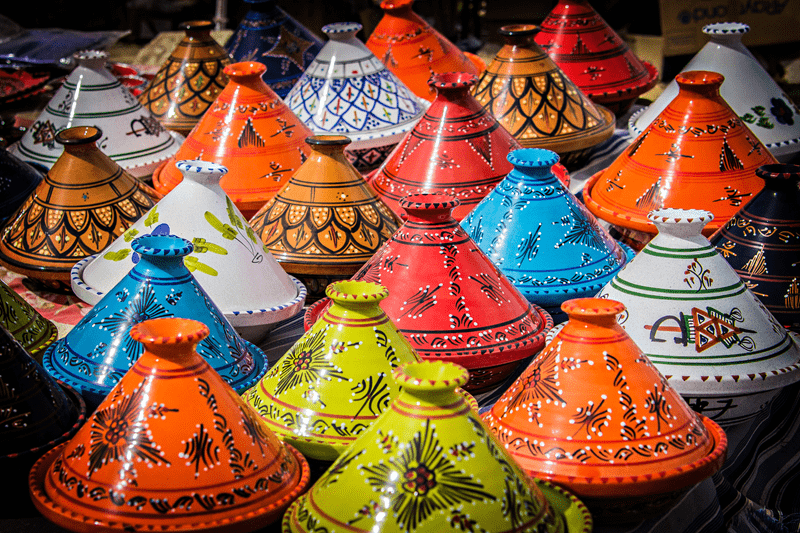
Berber food in Algeria is not just about eating. It’s about history, family, and the bond people share with their land. The Amazigh people, often called Berbers, have lived in North Africa for thousands of years. Their food tells stories of their past. It shows how they survived, celebrated, and cared for one another.
Every dish comes from a simple idea — using what nature gives. There’s no show or exaggeration in this cuisine. It’s natural, humble, and full of meaning. That is what makes it stand out.
Amazigh cuisine started long ago when people lived off the land. It grew from the earth, the mountains, and the desert. People cooked what they could grow or find. They used barley, wheat, vegetables, and herbs. People who lived in desert relied heavily on preserved foods, whereas, people in the mountains were able to consume grains and fresh products.
The process of cooking was always slow and steady, as they used clay pots over open fires. It gave the food time to develop its deep and natural taste. Almost every family followed this method of cooking and passed it down quietly from one generation to another.
This way of cooking wasn’t just about food. It was a way of living. People cooked together, ate together, and built their lives around these meals. Even today, Amazigh cuisine carries the same rhythm. It is simple, honest, and deeply connected to nature.
In the Kabyle region of Algeria, food has always been at the center of life. It reflects strength, warmth, and respect for family. Kabyle dishes are full of meaning, and they always have a story behind them.
One of the most loved Kabyle dishes is Couscous. It’s made with semolina, steamed until light and soft. Sometimes it’s served with vegetables, sometimes with chickpeas or lentils. It’s eaten during celebrations, family gatherings, or even regular Fridays. The dish brings people together. It reminds them that food tastes better when shared.
Then there’s Tajine Lahlou, a slow-cooked dish made with vegetables and sweet flavors. It’s simple but full of comfort. It’s often cooked for guests or during special events. People believe it represents kindness and generosity.
And of course, there’s Aghroum, the traditional bread. It’s made with hands, baked on hot stones, and shared at every meal. It’s not just bread. It’s the heart of the table. Every bite feels familiar, warm, and real.
These Kabyle dishes may look simple, but they carry meaning. They represent unity, respect, and the old rhythm of life that people still hold on to.
Berber meals have always been built on simple routines. They are made from what is available, cooked with patience, and eaten with joy. Nothing is wasted.
Asemmoun is one such meal. It’s a porridge made with barley or wheat. People eat it with olive oil or milk, especially in the mornings. It keeps them strong throughout the day. Another well-loved meal is Chakhchoukha. It’s made with pieces of torn flatbread mixed with sauce and vegetables. It’s a dish that fills the room with warmth and brings families together.
Olive oil is like gold in Amazigh cuisine. Almost every family has olive trees. They make their own oil and use it in everything — cooking, baking, even blessing a new home. It’s more than an ingredient; it’s a part of their culture.
Meals are eaten together. Everyone sits around a single dish. They eat by hand, taking what’s close, and leaving enough for others. There’s something honest in that. Something peaceful.

Some dishes are more than just recipes. They are the identity of the Amazigh people. They connect generations and remind them of their past.
This dish is more than food. It’s a symbol of togetherness. Every family has its own version, but the feeling it brings is always the same.
Cooked slowly in clay pots, Tajine combines vegetables and herbs in the simplest way. It reminds people of home and calm evenings.
This traditional bread is baked fresh every day. It’s part of every meal, and its smell fills homes with warmth.
These dishes keep the memory of Berber life alive. Each one carries a part of the story that has traveled through centuries.
The taste of Berber food in Algeria comes from its ingredients. They are simple, but each one has meaning.
Barley, wheat, lentils, and chickpeas are used in most meals. They keep people full and strong.
Fresh vegetables like carrots, onions, and turnips are common. Herbs like mint and thyme add a touch of freshness.
Olive oil is the heart of Kabyle dishes. It brings flavor and tradition together in every spoonful.
These ingredients show how the Amazigh people live close to the land. They use what they grow and respect what they have. The food feels real because it is made with care.
Berber recipes are not written in books. They are remembered in hands and hearts. People learn them by watching, not reading.
Everything was done with hands like the grains were grinded, the dough was kneaded, and the food is shaped. It was a slow process, but it brought everyone together.
The meals were cooked over open flames or in clay pots. This allowed the food to capture the smell of smoke and the sound of bubbling sauce. All these things made the experience even better.
No meal was complete without sharing it with other. Families gathered around one dish and ate slowly, while talking. This is how love and stories passed from one generation to the next.
In every home, there’s a moment like this — a grandmother teaching her grandchild to roll couscous or knead dough. That’s how recipes survive. They are never lost.
Berber food in Algeria is a quiet story told through flavors, family, and time. It is the taste of the land and the memory of ancestors. Every dish connects people to who they are and where they came from. Through Amazigh cuisine, the Berber spirit continues to live — strong, proud, and full of life.
This content was created by AI